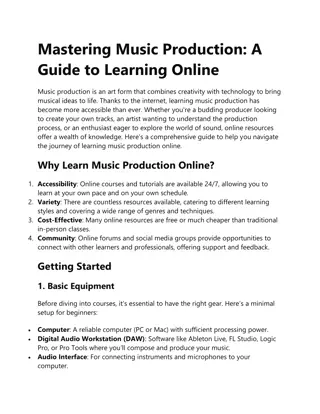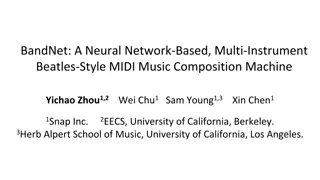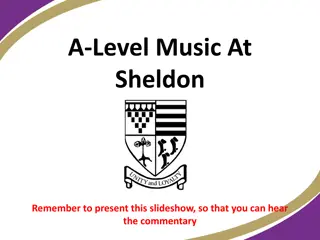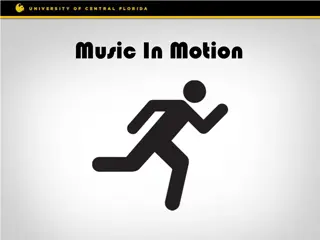Ultimate Guide to Monitoring in Music Production
Exploring the importance of monitoring in music production, this guide covers topics such as types of monitoring, reference monitors, performance specifications, and terminology. It emphasizes the need for accurate response in pro-studio monitoring systems and distinguishes between hi-fi and lo-fi equipment. Additionally, it explains why equipment with bass boost or noise filtering features may not be suitable for referencing purposes.
Download Presentation

Please find below an Image/Link to download the presentation.
The content on the website is provided AS IS for your information and personal use only. It may not be sold, licensed, or shared on other websites without obtaining consent from the author.If you encounter any issues during the download, it is possible that the publisher has removed the file from their server.
You are allowed to download the files provided on this website for personal or commercial use, subject to the condition that they are used lawfully. All files are the property of their respective owners.
The content on the website is provided AS IS for your information and personal use only. It may not be sold, licensed, or shared on other websites without obtaining consent from the author.
E N D
Presentation Transcript
Essential Guide to MONITORING
Aims To understand the following: What is Monitoring Types of Monitoring Speakers & Headphones What is Reference Monitoring Performance -Frequency Range Performance Power Ratings / Volume / SPL Manufacturer s Spec of Yamaha HS50M Manufacturer s Spec of HD280 Pro Terminology
MONITORING Monitoring is essential in recording as it allows you to hear. Monitoring is required for: To soundcheck and set levels 1) 2) To audition a signal before recording 3) To perform along to a previous recording or guide 4) To arrange a multi track recording 5) To measure the results of processing (Effects, EQ etc) 6) To mix a multi-track recording 7) To master a multi track recording
MONITORING Two essential monitoring systems: 1) Reference Monitors 2) Reference Headphones
MONITORING Note the word Reference This is a very important attribute for a pro-studio monitoring system. Refers to: Accurate Response
HI-FI Hi-Fi, or High-Fidelity Designed to be high quality. Traditionally accurate in response More recently feature: Bass Boost EQ Noise Reduction Artificial environments Surround
LO-FI Lo-Fi, or Low Fideltyequipment such as Computer Monitors. Limited Frequency Response
BASS BOOST Any equipment with additions such as Bass Boost, Dolby Surround, Noise filtering, or that is not true stereo, cannot be used for referencing. Why?
REFERENCE MONITORS Two types of Referencing Monitor speakers: 1) Nearfield 2) Midfield
NEARFIELD MONITORS Nearfield Designed for close monitoring in a small studio and tend to have 2 or 3 cones or horns per unit.
MIDFIELD MONITORS Midfield More powerful and designed for larger studios. Tend to have at least 3 cones or horns per unit.
REFERENCE MONITORS NB: As monitors need to be turned up to maximum volume for optimum frequency response, if you use Midfield monitoring in a small studio you will probably damage your ears.
MEASURING THE PERFORMANCE OF MONITORING SYSTEMS All monitors, headphones and speakers are measured in several ways, these are the two most essential: 1) Power in Watts. This is how powerful the equipment is. (Volume /SPL) 2) Frequency response in Hz. This is the bandwidth of the audio spectrum that the unit is able to deliver.
YAMAHA HS50M STUDIO MONITORS
YAMAHA HS50M STUDIO MONITORS 2 Way True Reference Monitor 5 Cone Woofer, Dome HF Unit 70 Watts Power Frequency Response 55Hz 20khz Mid EQ Room Control & High Response Control Switches Low Cut Switch Crossover Freq 3Khz www.uk-yamaha.com
HEADPHONES Headphones are simply mini-monitors. They are close range so there is less need for different power ratings and configurations. Like speakers, headphones are rated by power and frequency response. There are other factors to consider when choosing headphones for studio use...
DIFFERENT TYPES OF HEADPHONES
DIFFERENT TYPES OF HEADPHONES Circumaural Headphones (Noise Cancelling) Encompass the whole ear Fully seal against the head to cancel out background noise
DIFFERENT TYPES OF HEADPHONES Supra-Aural Headphones Press against the ear Less attenuation of background noise
DIFFERENT TYPES OF EAR CUP Open Back Allow background Noise in Allow noise to escape They give a more ambient and speaker-like response Deliver sense of distance from the sound source
DIFFERENT TYPES OF EAR CUP Closed Back Block background Noise Prevent noise escaping Give a much closer sounding response
WHICH SET? In a studio setting you need the following: 1) Closest, most accurate sound (no enhancement) 2) No bleed (sound should be sealed in so it is not picked up on the recording) 3) Outside sound blocked out to help accurate monitoring
WHICH SET? Circumaural, Closed Back, Full Frequency Range, Referencing Headphones with no Bass Boost or Noise Reduction.
Sennheiser HD280 Pro Closed Back Headphones
Sennheiser HD280 Pro Closed Back Headphones 32dB Background Noise Attenuation Power Rating 500mw Frequency Response 8 25000hz SPL: 102dB (1 mw of input signal = 102dB) THD 0.1% Closed Back Circumaural design for limited overspill Accurate Linear Response http://en-uk.sennheiser.com
References www.howequipmentworks.com www.thomann.de www.mixonline.com www.uk-yamaha.com http://en-us.sennheiser.com http://en-uk.sennheiser.com http://shure.custhelp.com/























